This article is one of our multi-part series Behind The Wheel – The Complete Guide To Teen Driving. Other articles include (those not linked are in production and coming soon):
- 9 Important To Do’s Before Your Teen’s First Time Driving
- THIS ARTICLE: How To Teach Your Teen To Learn To Drive
- The Best Cars For New Drivers | 2015-2021 Models
- The 17 Positively Essential Gifts For New Drivers
- Help your teen avoid negligent driver schemes and accident fraud
- Monitoring your new teen driver
- What to do if involved in an accident including a printable to keep in the glove compartment
- Tips for finding the best rates on teen car insurance
- What every teen should keep in their car
To be notified when new articles drop, please subscribe to receive our emails or follow our Facebook page.
Ready or not, it is time to teach your child to learn to drive!
As I’m sure most of us can agree, these mid-teen years are often full of eye-rolling, unexpected emotional outbursts, brooding, unwillingness to accept responsibility and not-so-subtle maneuvers to create separation from their parents. All normal. All maddening. But throw in trying to teach them a pretty stressful life skill, and it can quickly spiral into agonizing frustration for both of you.
This is precisely why Positively Squared Away put together this step-by-step guide to teaching teens to learn to drive. Having a plan will set expectations and help reduce stress and uncertainty for both you and your teen.
In addition to having a plan, this guide also intends to:
- Help prepare your teen for their road test (also called driver’s test or behind the wheel test).
- Help you both feel confident when they head out for their first time driving on their own.
We have consulted the road test guides for states across the US and have incorporated the skills that will be tested at their driver’s license test into this guide. In addition to these technical road skills, you will also find a series of other skills and lessons of driving that are key to producing safe teen drivers.
How Long DOES It Take To Teach A Teen To Drive?
There is purposely no set timeline with this guide. Every teen is different in terms of maturity, level of readiness to learn driving, and ability to accept and respond to constructive feedback. In fact, some of you will be managing how to teach a scared teenager to drive. You’ll need to find the right pace and advance to the next step when you feel your teen (and you!) are ready.
Before you get started
Before you proceed, please be sure you’ve read our article on the 9 Important To Do’s BEFORE your teen’s first time driving. One of those to do’s is to get a Student Driver magnet for your car. I would definitely do this before you head out on the roads for a teen driving lesson.
If you really want to get those eyes rolling, get a clipboard, print the driving lessons below and bring it all out to the car with a pen to take notes. Send us pictures of their expression!
Pack Your Patience – It’s A Big Job To Teach A Teen To Drive
If you are teaching a beginner to drive, you must start by stocking up on patience. This is especially true when teaching teens to drive because as you know, they can be sensitive, touchy, quick-triggered, hormonal, unpredictable, you name it. Take a deep breath and get ready for the new teen driving experience!
Step 1: Empty Parking Lot Practice
You’ll definitely want to have your first driving lesson in an empty parking lot, the best place to first learn to drive. In the first article in this series, I suggested ways to find empty parking lots near you if you need ideas.

The parent should drive to the empty parking lot, emphasizing examples of good driving as you see them on the way, and upon reaching the empty parking lot, turn off the car and switch seats.
With your teen now in the driver’s seat, get them setup and oriented with their surroundings:
- Put their phone away. Preferably in the backseat, but definitely NOT in their pocket where they will feel it buzzing. In fact, this would be a good time to turn off all notifications.
- Put on their seatbelt.
- Make sure the car is in PARK and turn the car on.
- Get familiar with basic controls:
- Adjust audio volume.
- Set the temperature and air flow.
- Adjust the seat, steering wheel, rearview and side-view mirrors.
- Turn the left and right turn signals on. EVERY time they make a turn, use turn signals – make this a habit, even in an empty parking lot.
- Note gas tank level and any warning lights.
- Show them how to turn on the Emergency Flashers and discuss when those should be used.
LET’S GET DRIVING:
- Use good posture. Sit up, both hands on the steering wheel, no elbow on the arm rest or window, etc.
- Glance briefly at rearview and side view mirrors.
- Put the car in DRIVE, and drive forward slowly, then practice braking slowly.
- Rotate between slowly driving straight and practicing turning and braking.
- Practice maintaining speed at 5mph, 10mph, etc and then gradually braking.
- While stopped, have your teen consult the rear and side view mirrors so they can start to understand what they can and can’t see. Discuss blind spots from the side mirrors.
- Practice parking and backing out of a space. Make sure your teen is looking over their shoulder and not relying on backup or other cameras. Backup cameras are not allowed at road tests.
- Stop in a parking space and use the parking brake, even though you’re probably not on a hilly space. Undo the parking brake and continue to practice driving.
- Use the long white line to simulate driving with the center line on their left. When they get on the roads, they all hug the curb at first because they’re nervous about oncoming traffic and being too close to the line.
- Come to a complete stop and then have your teen attempt a u-turn. This is a good way to get a feel for turning radius and steering wheel sensitivity.
- Have your teen try backing up in a straight line. At first, go the length of a few parking spaces, but gradually see if they can do 50 feet as that is often required on the road test to get their driver’s license. Focus on driving straight and maintaining a consistent, slow speed. Make sure they are looking over their shoulder and not at a backup camera. Bring a piece of paper to cover the screen if you think that will reduce the temptation.
- And while you are in an empty parking lot, have them try backing into a parking space. Have them look over their shoulder to do so. This may be difficult on their first outing or two, so you might consider delaying this skill until a later time.
It is fine if they’re feeling uneasy after their first driving lesson. Kids learn at different paces, and your teen probably has plenty of mandatory learner’s permit time to learn to drive slowly.

Click to download the Step 1 Checklist as a PDF.
If given the option, don’t open the PDF in Google Docs, it will not keep the correct formatting.
You should both decide if your next outing will be a repeat of this one or if your teen is ready to move to the next driving lesson.

Step 2: Busier parking lot practice
Once your teen feels comfortable with the basics from step 1, it is time to work around a few obstacles such as slowly moving cars and shoppers (who are probably walking while looking at their phones). One of the important lessons of driving is not to rely on pedestrians or other drivers to do what you expect.
Identify a parking lot with a few patrons but not during the busiest time of the day.
Once there, have your teen practice the following driving skills:
- Maintain a slow speed throughout the parking lot.
- Practice using the side and rearview mirrors.
- Make full stops at the end of each aisle.
- Not getting rattled if a car pulls up behind them and seems impatient with the speed and full stops. This is good practice before driving on the roads.
- Always use turn signals, even if no one else is in view.
- Use turn signals going into and out of parking spots. This should be part of your road test, so build the habit now.
- Look both ways before proceeding after any stop.
- Don’t try to anticipate what a person, especially a child is doing in a parking lot. They can stop or change direction in a split second.
- Park next to one car but with a space open on the other side of where you are parking.
- Back out of that space and continue to practice driving and parking
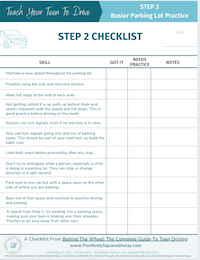
Click to download the Step 2 Checklist as a PDF.
If given the option, don’t open the PDF in Google Docs, it will not keep the correct formatting.
Step 3: Neighborhood DRIVING Practice
I know this isn’t going to be an easy task for city dwellers, but hopefully you can find the time to take a car out to the suburbs for the first few actual road driving lessons. Neighborhoods are one of the great places to practice driving.

I like to scout out neighborhoods that have nice wide roads without a lot of cars parked on the street. If you can find neighborhoods with stop signs, turn lanes, hills, even traffic circles, those are all great for driving practice while not experiencing a lot of traffic.
While in the neighborhood, practice good driving skills including:
- Noting the speed limit and maintaining a safe speed.
- Coming to a gradual complete stop at stop signs.
- Always use turn signals, even if no one else is in view.
- Gradually and smoothly starting after a stop.
- Practice making turns, especially right turns. Apparently, new drivers don’t like these at first because they can’t see out of that side of the car.
- Scanning for children, pets and other potential hazards.
- Keeping to your side of the road without getting too close to the curb especially if there is oncoming traffic.
- Practice using the side and rearview mirrors.
- If you pull up behind another car, practice finding a safe distance to stop. A tip is to be able to see the tires on the car stopped ahead of you.
- Discussing what to do should your teen driver encounter a school bus, a garbage truck or a mail or package carrier.

Click to download the Step 3 Checklist as a PDF.
If given the option, don’t open the PDF in Google Docs, it will not keep the correct formatting.
LEARN To Drive In Traffic Circles
In our suburban town, there are MANY traffic circles on the more heavily traveled 2-lane roads, and I’m seeing more and more of these being built around Georgia. It is quite obvious when inexperienced drivers try to navigate traffic circles, so if you could please educate your teen on how to drive through them, we would all appreciate it!
The main rule of traffic circles is that cars already in the circle ALWAYS have the right of way and should never slow or stop to let other traffic enter the circle. But always consider that a car could break the rules and dart into the circle in front of you.
If you are approaching a traffic circle, you must wait for an opening before you can enter the circle.

Step 4: Suburban Roads
Once your teen has mastered parking lots and neighborhood roads, they can now learn to drive on actual roads that connect people to places. But a warning, driving with the yellow line down the middle and oncoming traffic is often intimidating to new drivers. If you’re like me, you’ll be leaning toward the middle of the car because you feel like you’re too far to the right.
Try to gently coach your teen to center the car in the middle of your lane without risking mailboxes, trash cans and street signs on your right. It will take some time, and you’ll need to learn to quietly grimace through it until they get more comfortable with oncoming traffic.
For the first driving lesson on well-traveled roads, select a destination not too far from home such as the grocery or drug store. Your teen will be more relaxed knowing they’ll only drive for a short while and then will have a break.
Have your teen practice the following good driving habits:
- Note the speed limit on each road and maintain safe speeds.
- Keep a safe following distance adjusting for speed (more distance at higher speeds).
- Find the middle of your lane and practice staying in it even when cars are coming the other way.
- Have a plan should they come upon a bicyclist, a school bus, a garbage truck or a mail or package carrier.
- Scan for hazards that could enter the roadway such as children, pets or even other vehicles.
- Approach traffic lights cautiously and never assume other cars at the intersection will abide by the traffic light.
- Come to a complete stop at stop signs and discuss how to handle right of way at 4-way stops.
- Always use turn signals, even if no one else is in view.
- Practice using the side and rearview mirrors.
- Keep in mind that your teen likely will not like right turns. Hopefully they’ll have the chance to practice those.
- In addition to stop signs and traffic lights, have your teen monitor any pavement markings and other road signs. Remind them that there is a lot to keep an eye on and respond to, and this is why distracted driving is so dangerous.
I’d recommend doing a good bit of driving on these less busy suburban roads with a yellow line until your teen is feeling comfortable behind the wheel. At that point, move on to Step 5.

Click to download the Step 4 Checklist as a PDF.
If given the option, don’t open the PDF in Google Docs, it will not keep the correct formatting.
DEALING WITH Other Drivers
Our older son really struggled with cars tailgating him when he started learning to drive. It made him very anxious, and I just sat calmly and kept reiterating that it’s not his responsibility to go faster just because the car behind him is in a hurry. After witnessing a few angry spells (nerves coming out as anger), I decided he needed the “student driver” magnet on the car. At least that would hopefully give pause to some of the impatient tailgaters out on the roads.
A good driving tip is that if someone is following too close behind, you need to add a little extra space to the car in front of you. You are now stopping for 2 cars and you need to make sure you have plenty of time to stop without the guy behind you running into you.
I also tried to tell him that people are going to do stupid things, and if they’re really bothering you, find a place to pull over, and let them pass. Some people are just irresponsible drivers, but maybe someone just found out someone they love was in an accident and they’re hurrying to get there, or that there’s an emergency at home that they need to get to, you just never know, and so just give them some grace and let them get on their way. Remind your teen driver that it is not worth getting angry or upset about things or people that you can’t control.
Documentation of your teen’s safe driving
Now that he’s driving on his own, he’s told us of a few episodes of tailgaters and other bad drivers. And he’s even shown us a few on his dashcam. Dashcams are a highly recommended device for the cars that your teens drive. There’s a full article coming on this soon, but for now, please know that there are a lot of scammers out there. Scammers are looking for teens and older folks in nicer cars and intentionally causing minor accidents in order to sue their insurance companies for a big payout.
In addition to intentional scammers, there are unscrupulous people out there who are quick to blame teens for an accident by trying to exploit their inexperience. Unfortunately, the teen is likely scared and not really able to really defend themselves against an adult who is doing all of the talking and blaming.
A great way to combat both of these situations is by installing a dashcam. We have this dashcam in the 2 cars our kids drive, and it definitely provides peace of mind knowing that we will have proof if they weren’t at fault. With the cost of teen insurance these days, an under $200 investment could easily pay off several times over.
Step 5: Locally Busy Roads/4-lane roads/TRAFFIC
The next step in teaching teens to drive is really getting out there in the real world. Busier roads with shopping, businesses and schools are where the rubber literally meets the road.
When you’re both ready, have your teen drive you to a more populated, busy area. Try to stick to locations that they already know so that they’re comfortable with the surroundings. You’ll probably find that they are not all that familiar with the names of the roads since they never had to pay attention before, so be sure to be clear with directions. For example, tell them to turn right at the next light onto Market Street versus just saying turn right on Market Street.
This is also an important time to reiterate how and when to use the side and rearview mirrors to help them be aware of their surroundings. You want to be sure they are comfortable with these before proceeding to highway driving.
Some skills/habits to practice at this step:
- Always come to a full stop at stop signs.
- Do not try to run yellow lights.
- Be sure to stop before a crosswalk at traffic lights and not encroach into it at all.
- Regardless of stop signs and traffic lights, your teen must ALWAYS look both ways before proceeding forward or turning and be sure to use their turn signal if they are turning, even if no one else is around.
- Always be sure pedestrians are not coming into your roadway even when you have a green light – they don’t always follow the pedestrian rules.
- Find a place to practice following a YIELD sign, possibly one road merging into another road. This will be good practice for eventual highway driving. Be sure not to stop unless you must yield to oncoming traffic in order to avoid confusing the driver behind you.
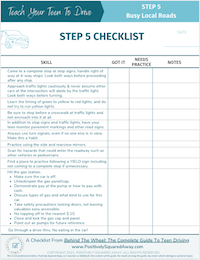
Click to download the Step 5 Checklist as a PDF.
If given the option, don’t open the PDF in Google Docs, it will not keep the correct formatting.
Learn To Drive While Running Errands
Decide on an errand together and have your teen drive you there. Some good errands with teaching opportunities included are below. And once you head out, don’t decide you need to pop into CVS on the way to the bank if your teen thinks they’re just going to the bank. Stick with the plan these first few times. You can throw curve balls at them later.
Teach Your Teen How To Pump Gas
A good errand would be a trip to the gas station to let them pump the gas. While you are there:
- Obviously, make sure the car is OFF.
- Show them how to open the gas tank. I know in one of our cars, the gas tank won’t open if the car doors are locked.
- Demonstrate the pay at the pump function and/or how to pay with cash.
- Discuss the types of gas and what kind of gas to put in your car.
- Teach them to lock the doors as they exit the car and not to leave valuables on the passenger seat such as a purse or a backpack. These are sad realities, but they need to be taught to everyone learning to drive.
- Don’t let them top off the gas to the nearest $.10. Apparently, my son came prewired to do that.
- Point out where the air pumps are for future reference (this will be covered in an upcoming article).
Curbing Hunger Pangs Through The Drive-Through
Teens are always hungry, right? And once they can drive on their own, one of the first places they may go is to pickup fast-food. My boys each did their inaugural solo drive to Dairy Queen.
Navigating drive-throughs can be tricky, especially in a bigger vehicle or a particularly narrow drive-through lane. It certainly can’t hurt to go through a couple of drive-throughs with them while they get the hang of driving, ordering, handing off food and making sure everyone has napkins (ha!). Obviously, take the food home, no eating in the car for sure!
Learning Debits and Credits At The Bank Drive-Through
With the advent of Venmo and other cash apps, our kids will do much less in-person banking than we did at their age. My kids’ hourly jobs both pay them via direct deposit, so they rarely need to go to the bank. But if you have a bank errand to run, let them take you especially if there is a drive-through for driving practice.
This can be a great time to talk about managing and saving money, especially when they’re learning to drive and dreaming of their own car one day. It can’t hurt to start educating them on the overall cost of ownership of a car. The purchase is just the beginning, they also need to consider insurance, gas, annual license/tag fees, maintenance and repairs. And that cars are a depreciating asset, certainly not an investment.
Step 6: How To Teach YOUR TEEN TO Parallel Park
This is probably the most troublesome part of how to teach a teen to drive. If you want to save everyone a little stress, I would initially teach your teen how to parallel park using cones or other soft items instead of between 2 parked cars. Our high school had cones setup to help with carpool, so we went there on a weekend and practiced parking between two of them.
If you can’t find any to ‘borrow’, you can easily get them at Home Depot, Wal-Mart or Amazon. Or even check with your local police or fire station and see if they will let you use their parking lot and a couple of traffic cones. You could also use empty rubber trash cans or look for other props you might be able to use in your garage.
If you decide to get your own cones, be sure to get at least the 28″ height (the 18″s are too short).
You can go with the taller delineator style. These are 45″ tall and come as a set of 2. The taller height would be helpful if your teen is learning to parallel park without using a backup camera as these should be visible looking out the back window. These would also be better if your teen is learning in a truck or SUV.
These 28″ orange cones will also work. They’ll come up about mid-bumper on most cars and small SUVs. You could always put a flag or even a broomstick into it for higher visibility purposes.
Grab a tape measure and head to your practice location. This could be your driveway or a not busy road near your house. It would definitely be best to have a curb involved.
Parallel Parking Cone Setup
Place 2 cones, delineators, flags, trash cans or shopping carts 1.5 car lengths apart. See, this is why you need a tape measure.
Parallel Parking is something better taught by video than written explanation, so I scoured the internet to find the most straightforward simple video, and this parallel parking instruction video is the winner. Please have your teen watch this video several times before giving this a try on their own.

Your teen’s road test will likely utilize cones to test this driving skill, but if you and your teen are feeling ready, look for an area to practice parking between cars where the space to parallel park is relatively forgiving.

Click to download the Step 6 Checklist as a PDF.
If given the option, don’t open the PDF in Google Docs, it will not keep the correct formatting.
STEP 7: HOW TO DO A 3 POINT TURN (AKA TURN ABOUT)
Most states’ driver’s license road tests will include testing new drivers on their ability to do a 3 point turn, sometimes called a turn about. This is a skill needed should you find yourself unable to proceed forward and need to turn around. This could be due to a dead-end, blocked traffic or other obstruction in the road.
The 3 point turn is a rather simple procedure done at slow speeds and should be practiced on a very quiet road, a dead-end road or toward the end of a cul-de-sac road would be good options. Otherwise, you could use cones set 20′ apart to simulate the edges of a typical two-lane road.
This is another skill that is probably more easily taught by watching a video. Please see this How To Do A 3 Point Turn video.
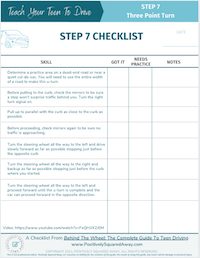
Click to download the Step 7 Checklist as a PDF.
If given the option, don’t open the PDF in Google Docs, it will not keep the correct formatting.
Step 8: LEARN TO DRIVE AT NIGHT
You’ve conquered a lot of driving skills up until this point, and hopefully, you and your teen are in a groove now and things aren’t quite as stressful. These last 3 steps continue to build in complexity, but you’ve got a good foundation, and you are ready to put some of these skills to work after the sun goes down.

The first step is to make sure your teen knows when the headlights must be on. By law, you must turn on your headlights:
- 1/2 hour after sunset to 1/2 hour before sunrise
- Any time the windshield wipers are in use, including in fog
- When visibility is less than 500 feet
When driving at night, you should teach your teen:
- Most importantly, lower your speed. Your reaction time will always be slower at night.
- Provide even more safe following distance as other drivers are more likely to make a quick move.
- Never drive with the interior overhead lights on.
- Dim your interior lights although most cars do that for you these days.
- Make sure you’re rested. Circadian rhythm is not very forgivable.
- Know when to use high beams or low beams.
- Avoid looking at the headlights of other cars.
- Be extra cautious of other drivers. Despite the major campaigns against drinking and driving, some people still make really terrible decisions.
- Keep your windshield clean.
- Look out for animals. I hit a deer once in North Carolina. Driving along on a dark road with the high beams on, another car was approaching, so I clicked off the high beams, and boom, a deer ran straight into the front corner bumper. The theory is that the deer was ‘frozen’ by the high beams, and as soon as I lowered them, it ran. The wrong way. Luckily, I wasn’t hurt, but deer can be disastrous.
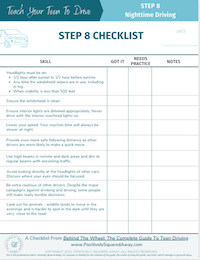
Click to download the Step 8 Checklist as a PDF.
If given the option, don’t open the PDF in Google Docs, it will not keep the correct formatting.
Do NOT Flash Your HEADLIGHTS At Oncoming Traffic
Here is a recent learning from my 18-year-old. He was out delivering for Door Dash one evening, and he saw a police officer parked facing the road presumably looking for speeders. My son, being the ever-helpful child, flashed his headlights at the first car coming the other way to warn them. And then he did it again to the car right behind the first. That second car….turned on its blue lights, did a 180, and came up and pulled over our very helpful son. First time pulled over, two friends in the car, and it seems the officer couldn’t be nicer.

The Officer explained to my son that usually when police cars are sitting facing the road like that, it’s not necessarily as a speed trap. In fact, it is often because the police vehicles are equipped with license plate readers and are trying to find someone who is wanted by ours or a nearby police department. So by my son warning cars of a police presence, he could be warning rapists and murderers (the Officer’s words, not mine) to turn off the road to avoid being detected. That was a HUGE lesson for our whole family, I had no idea. Neither did my husband. But I can guarantee you that no one in our household will EVER flash their lights to warn oncoming cars of a police presence again.
Step 9: Inclement Weather Practice
Hopefully, by now, your teen is starting to feel pretty comfortable behind the wheel, and you’re feeling pretty accomplished at how to teach a teen to drive. Right? If so, you should plan to get in some driving practice during inclement weather before your teen starts driving on their own. While the DMV probably won’t run their road tests during rain or snow, you’ll want the peace of mind knowing that your teen has had experience driving in bad weather.
Depending on the typical weather conditions where you live, you’ll want to help your teen practice driving in the rain, fog, sleet and snow.
Teach your teen:
- Slowing down at least 5-10mph to allow for slower braking conditions and less predictable maneuvers from other drivers.
- Allowing double the following distance to also allow for braking conditions and unpredictability.
- When to use headlights and fog lights.
- How to use windshield wipers including different frequencies of intermittent wipers.
- When and how to use the front and rear defrost.
- Navigating large puddles and anticipating the wash coming from oncoming cars going through large puddles.
- The practice of testing the brakes before you really need them.
- How to use other visual clues when the glare on wet roads makes road visibility difficult.
- The importance of checking the windshield wiper fluid level and confirming it has de-icing agents in it if you are in a colder climate.

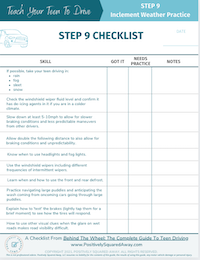
Click to download the Step 9 Checklist as a PDF.
If given the option, don’t open the PDF in Google Docs, it will not keep the correct formatting.
If you live in a warmer weather climate as we do, the snow practice may be tough to find. And honestly, most people here in Atlanta don’t know how to drive in the snow. It is pure chaos when there is a dusting. But my Pennsylvania-raised hubby uses our rare snow opportunities to take the kids to an empty parking lot to help them get the feel for driving in the snow. If you have the opportunity, teach them the ‘steer into the skid’ recovery technique in a deserted parking lot.
Avoid teaching them to do donuts. Yes Greg, I am talking to you.
Step 10: Are You Ready? Its Time To Teach Your Teen How To Drive on the HIGHWAY.
Maybe you’re lucky and live in the middle of Montana with no interstates within 200 miles. Your teen will have plenty of time to practice driving on rural less stressful roads.
But most of us probably live within 20 minutes of an interstate or multi-lane highway, and so the driving lessons must eventually take that on-ramp onto the highway.
Start out in less busy areas of the highway
Find a few hours on a nice day and go ahead and drive your teen on the highway until you get away from where it is really busy. Head out of the city and past the big suburbs to a less-traveled part of the highway. Here are some topics for conversation on the way:
- Explain what you’re doing in terms of on-ramps, off-ramps.
- How you are using your mirrors to always know your surroundings.
- When and why you should change lanes, ALWAYS using your turn signal and checking blindspots.
- Safe passing distances – how far to go past the car you are passing before moving back into the lane.
- Watching for brake lights to anticipate traffic slowing ahead or possible hazards in the roadway.
- The importance of leaving more room as you’re traveling at higher speeds and it takes longer to stop.
- How the blindspot alert and lane change alerts work if your car has these features.
Put your teen behind the wheel
Once you’ve gotten away from the heavily traveled areas, exit and find a place where you can switch drivers.
- Agree that your teen will enter the highway, plan to keep to the right lane and stick to the speed limit.
- Let them practice keeping a safe speed and checking their mirrors while staying in the right lane until they feel comfortable.
- If you happen to come up behind a really slow truck or other vehicle, this may be a good time to teach them to pass on the left. If your car has blind spot detectors and lane change alerts, definitely talk to them about using those to assist but to always use their mirrors as well.
- Don’t forget to discuss how to handle traffic coming in from the on-ramps and providing courtesy for merging into the right lane.
- Continue on letting your teen get comfortable with the speeds, the multiple lanes and the traffic entering and exiting the interstate and determine when it’s a good time to turn around. Before you head back, decide how far your teen will drive. Will you have them go back to where they started (where the road is less traveled), or do you want to let them go back toward home? If you think they’re ready to keep going, have them agree that you’re going to stick with the right lane.
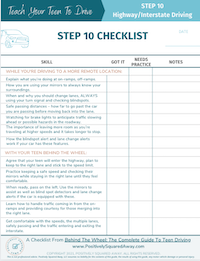
Click to download the Step 10 Checklist as a PDF.
If given the option, don’t open the PDF in Google Docs, it will not keep the correct formatting.
As your teen gets more practice with highway driving, be sure to mix in nighttime practice as well as inclement weather practice. If you live near other complicated features such as toll booths, reversible lanes, premium toll lanes, HOV lanes, it is definitely worth allowing them to navigate around those while you can help with questions or feedback.
The more time you can help them with highway experience, the better. From experience I can tell you, you will never be ready for them to drive on the highway alone the first time, but you will feel better knowing that they have had LOTS of practice.
THROUGHOUT EACH STEP, TEACH Defensive Driving
I spent a lot of time in the car with my grandmother in my tween years, and I distinctly remember her talking to me about her ‘what-if plans’ when she was driving. What if that car pulls out in front of us, what if the car in front of us slams on its brakes, what if the car in the lane to our left starts drifting into our lane? We came up with ideas for each of her scenarios. And while I don’t consciously work on this today, I do believe I’m always subconsciously coming up with what-if plans while I’m driving thanks to her instilling this in me tens of years ago.
Defensive driving is simply keeping your eyes ahead as well as using your peripheral vision to watch for and anticipate potential hazards and unpredictable drivers. It is much easier to do this if you’re not distracted which means keeping the music down, the phone out of arms reach and limiting other people in the car. I’m thankful our state does not allow new drivers to have any passengers, other than immediate family, for the first 6 months with their driver’s license.
As you go through the steps for teaching your teen to drive, keep defensive driving in mind, and if it will not rattle your teen too much, try to incorporate what-if scenarios into each of your lessons.
BEFORE YOUR TEEN’S DRIVER’S LICENSE ROAD TEST
In addition to the practice above, have your teen drive you around the area near the DMV or testing center where they will take their road test. Be sure they are familiar with the speed limits in the area, even if they are not posted. Practice the turns using turn signals, practice keeping the speed limit and get familiar with the roadways and intersections in the area.
Also, consider a refresh of some of the skills such as 50′ of straight-line backing up, the 3-point turn and parallel parking. All with the backup camera screen covered if you have one.
RECOGNIZE YOUR TEEN’S ACCOMPLISHMENT
Learning to drive is one of the key milestones of the teen years. It requires maturity, it breeds independence, and it requires continued practice and careful attention long after the driver’s license test is firmly in their wallet.
When you reach the point where your teen feels ready to take the road test for their driver’s license, be sure to recognize this accomplishment! Learning to drive can be stressful, and you want your teen to know that you are proud of them for working through it and getting ready to become a licensed driver.
While you’re at it, you deserve a pat on the back too. It is no easy feat to teach a teen to drive! Maybe it is time for a celebratory dinner or ice cream for both of you. Save the wine or beer until you’re safely at home. The adult driver in the car MUST NOT BE IMPAIRED while accompanying a student driver.
WHAT’S NEXT?
This article is one of our multi-part series Behind The Wheel – The Complete Guide To Teen Driving. Please check out our other articles including (those not linked are in production and coming soon):
- 9 Important To Do’s Before Your Teen’s First Time Driving
- THIS ARTICLE: How To Teach Your Teen To Learn To Drive
- The Best Cars For New Drivers | 2015-2021 Models
- The 17 Positively Essential Gifts For New Drivers
- Help your teen avoid negligent driver schemes and accident fraud
- Monitoring your new teen driver
- What to do if involved in an accident including a printable to keep in the glove compartment
- Tips for finding the best rates on teen car insurance
- What every teen should keep in their car
To be notified when new articles drop, please subscribe to receive our emails or follow our Facebook page.
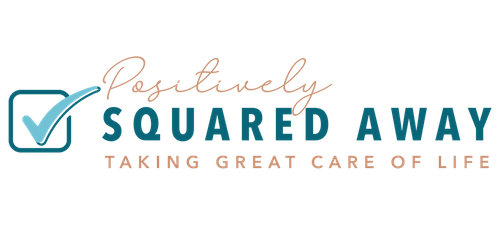








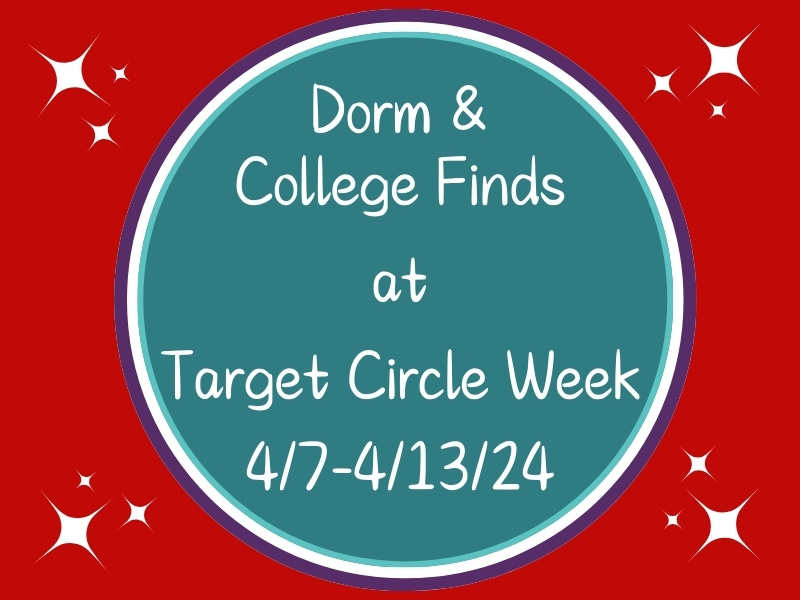


Definitely going to use these tips! Thank you!
These are great tips and checklists, very helpful! However, the link to the Step 4 Checklist took me to the Step 3 Checklist. Is there a way to get the actual Step 4 Checklist PDF?
Thank you so much for sharing, consolidating the information, and creating checklists! I am so excited to find such great resources to ensure that I have checked every skill off for my first teen driver!